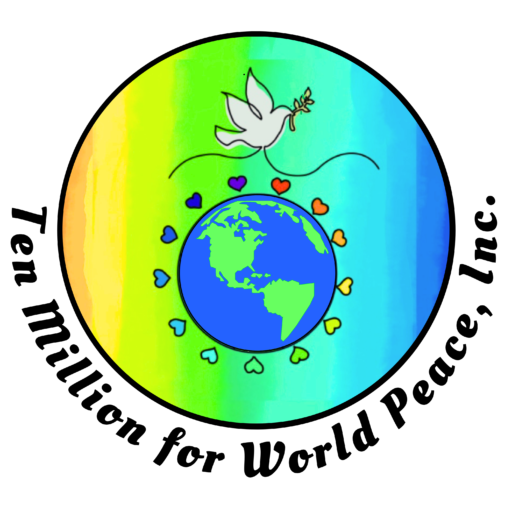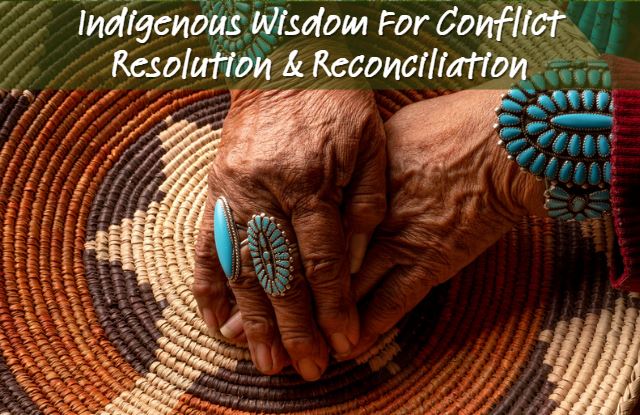When it comes to finding creative solutions for long-standing conflicts and cycles of violence, there is much to be learned from Indigenous wisdom traditions around the world. While modern peacebuilding and conflict resolution practices are relatively new fields, Indigenous communities have been walking the path of nonviolence, restorative justice, and reconciliation for thousands of years.
Their philosophies, stories, and ceremonies offer powerful guidance for transforming seemingly intractable conflicts, both on a global scale and within our own troubled hearts and divided communities. At their core is a shift away from dehumanizing “Us vs. Them” viewpoints and moving toward remembering our fundamental interconnectedness.
Navajo
For the Navajo people of the American Southwest, the guiding principle of walking in beauty (havazhu’) is about striving to live in harmony, balance, and right relationship with all living beings. Their idea of justice isn’t punitive or retributive, but centered on finding paths to restore broken relationships through dialogue, making amends, and healing generational trauma.
When conflicts arise, Navajo peacemaking circles bring together those directly involved, along with extended family and elders from the community. Each perspective is discussed, the roots of harm are carefully explored, and a mutual plan of action emerges through consensus. The ultimate aim is to re-establish hozhó, that state of universal connection and beauty.
South Africa
This cultural value of interconnectedness is echoed by the Ubuntu philosophy of South Africa, which views conflict as a profound violation of human bonds. The disagreement must be addressed through truth-sharing, empathy, and collective reconciliation. As Archbishop Desmond Tutu described it, “My humanity is caught up, is inextricably bound up, in yours.”
Instead of solely focusing on punishing perpetrators, the Ubuntu way emphasizes uncovering the full truth through restorative justice processes. This requires addressing the needs of all parties involved, and identifying how both victims and offenders can be supported in healing. In addition, they aim to reintegrate with their communities as fully human once more.
Hawaii
In Hawaii, the teachings of nonviolence and conflict reconciliation are related to traditional ecological knowledge about humanity’s sacred relationship to the land. Hawaiians apply the unifying concept of pono. This means to live with balance, righteousness, and peaceful intentions in all realms.
Their Indigenous leaders facilitate ho’oponopono family reconciliation practices and have done so for centuries. In these gatherings, divided family members engage in an open conversation with forgiveness, facilitated with prayer and bound by ritual. They take responsibility for making things right through tangible action to achieve mutual release, neutrality, and shared harmony.
Maori and Inuit
This concept of holistic connection between spirit, people, and land is woven throughout Native peacemaking practices around the globe. The Maori philosophy of Utu in New Zealand frames conflict as a violation of community wellbeing which must be rectified through collaborative accountability.
Then the Inuit peoples believe in resolving disputes through intentional dialogue and forgiveness. This process restores broken relationships to balance the entire ecosystem.
Tragically, these communities with the old wisdom, have been the targets of repression, violence, and cultural genocide by colonial powers for centuries. They understand the multi-generational impact of hurt and trauma better than many, which is what gives their teachings about peace such profound resonance.
Modeling Their Principles
As we grapple with conflicts at all levels of society today, Indigenous leaders are increasingly sharing their perspectives on pathways forward. They are modeling principles of restorative justice, sustainable peacebuilding, and reconciliation rooted in spiritual traditions and the belief in interrelatedness.
In an age of alienation, they ask people to remember that peace isn’t some lofty ideal, but about living in balance and right relationship with all people and all creation. At their core, conflicts represent a spiritual sickness of greed, hate, and delusion that can only be healed holistically by working for resolution and justice.
It’s time to learn from Indigenous elders and time-honored philosophies for healing harm, building peace, and mending the sacred hoop of humanity. This foundational transformation gives people hope for creating world peace that so many pray for daily.

